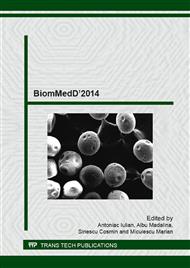[1]
A. Polikeit, S.J. Ferguson, L.P. Nolte, T.E. Orr, The importance of the endplate for interbody cages in the lumbar spine, J. Eur Spine 12(2003) 556–561.
DOI: 10.1007/s00586-003-0556-5
Google Scholar
[2]
J.F.I. Saldarriaga, S.C. Vélez, A.C. Posada, B.B. Henao, C.A.T. Valencia, Design and Manufacturing of a Custom Skull Implant, American J. of Engineering and Applied Sciences 4(2011) 169-174.
DOI: 10.3844/ajeassp.2011.169.174
Google Scholar
[3]
C. K. Chua, K. F. Leong, C. S. Lim, Rapid prototyping: Principles and Applications, second ed., World Scientific Publishing, Singapore, (2003).
Google Scholar
[4]
J. J. Beaman, C. Atwood, Th. L. Bergman, D. Bourell, S. Hollister, D. Rosen, Additive / Subtractive Manufacturing Research and Development in Europe, World Technology Evaluation Center, Inc., Baltimore Maryland, (2004).
DOI: 10.21236/ada466756
Google Scholar
[5]
BSL Bioservice Scientific Laboratories GmbH Munich, Biocompatibility Certificate, April 2001, https: /www. harbec. com/media/uploads/pa2200_certificate_biocompatibility_iso_10993-1_ 04-01_en. pdf.
Google Scholar
[6]
I. Gibson, D. W. Rosen, B. Stucker, Additive Manufacturing Technologies: Rapid Prototyping to Direct Digital Manufacturing, Springer Science and Business Media, LLC (2010).
DOI: 10.1007/978-1-4939-2113-3
Google Scholar
[7]
H.C.H. Ho, I. Gibson, W.L. Cheung, Effects of energy density on morphology and properties of selective laser sintered polycarbonate, J. Materials Processing Technology 89(1999) 204–210.
DOI: 10.1016/s0924-0136(99)00007-2
Google Scholar
[8]
F. E. Wiria, K. F. Leong, C. K. Chua, Modeling of powder particle heat transfer process in selective laser sintering for fabricating tissue engineering scaffolds, J. Rapid Prototyping 10(2010) 400-410.
DOI: 10.1108/13552541011083317
Google Scholar
[9]
EOS GmbH Electro Optical Systems. Formiga P100 prototyping machine of EOS Company: machine datasheet, polyamide PA 2200 properties, available on: http: /www. eos. info/fileadmin/user_upload/downloads_presse/pdf_files/FORMIGA_P_100_EN. pdf.
Google Scholar
[10]
W.A.Y. Yusoff, A.J. Thomas, The effect of employing an effective laser sintering scanning strategy and energy density value on eliminating orange peel, on a selective laser sintered part, IAMOT Proceedings, Dicec 6-10 april (2008).
Google Scholar


